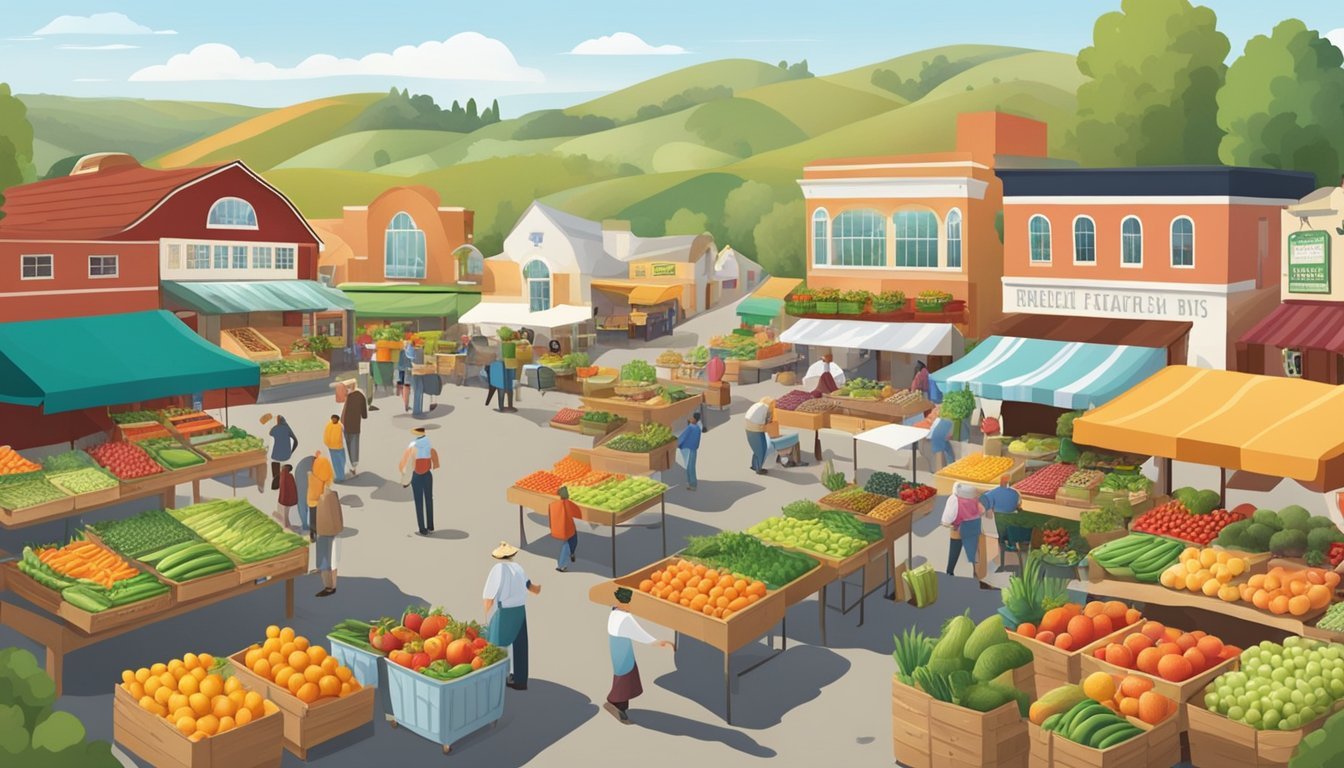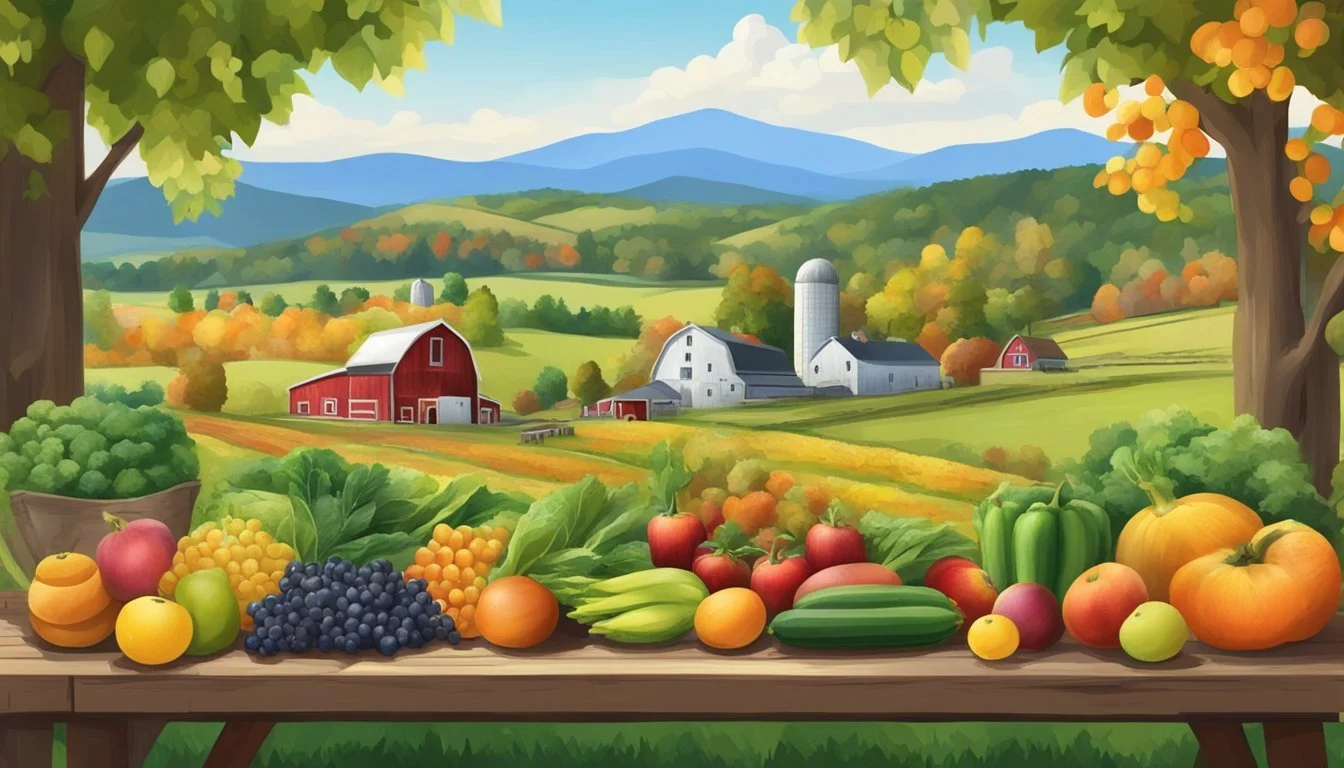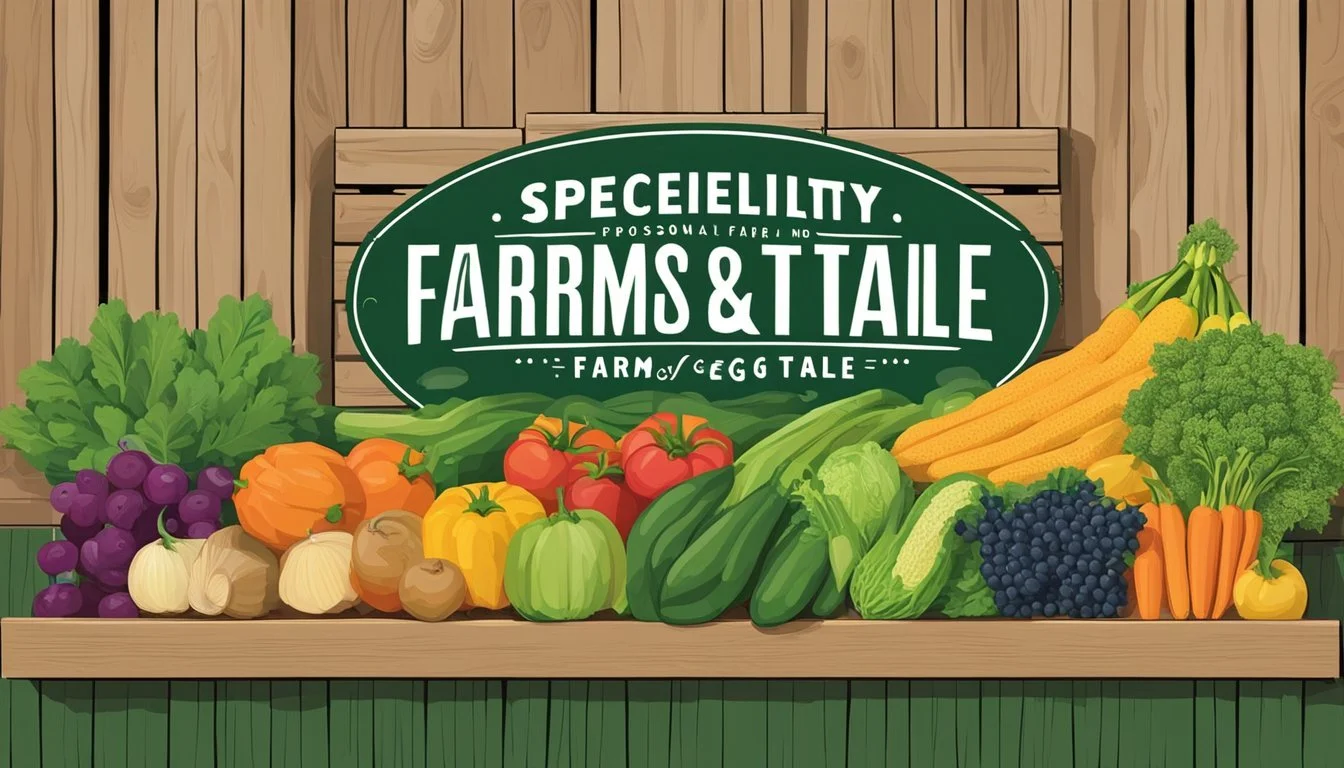Vermont Seasonal Fruit & Veg Guide
Your Monthly Shopping Companion
Vermont is renowned for its rich agricultural heritage and commitment to the farm-to-table movement, which emphasizes the direct sourcing of ingredients from local farms to dining tables. This approach not only supports Vermont’s economy but also ensures that residents and visitors alike have access to the freshest, most flavorful produce. Each season in Vermont offers a unique palette of fruits and vegetables, which can be experienced at their peak of ripeness. The seasonal availability of these home-grown treasures provides a canvas for both chefs and home cooks to create dishes that are as nutritious as they are delicious.
Understanding the rhythm of Vermont's harvests is key to appreciating its farm-to-table offerings. Spring brings crisp greens and delicate flavors to awaken the palate from winter's slumber. As the year progresses into summer, the bounty becomes more vibrant with juicy berries and plump tomatoes while fall ushers in a rich harvest of root vegetables and crisp apples (how long do apples last?). By aligning meals with the seasonal cycles, one can savor the distinct tastes and nutritional benefits that come with produce at its prime.
Incorporating this knowledge into daily life can transform the way Vermonters eat and connect with their community. Shopping at local farmers markets, joining a community-supported agriculture (CSA) program, or visiting farm stands become not only a way to procure ingredients but also an immersive experience in the state’s agricultural rhythm. Staying informed about what is in season and available locally enables consumers to make conscious choices that benefit their health, the environment, and the local economy.
What’s in Season in Vermont Right Now?
Understanding Seasonality in Vermont
Vermont’s seasonal produce offerings are closely tied to its varied climate throughout the year. Recognizing when fruits and vegetables are at their peak can enhance both nutrition and taste.
Climate and Growing Seasons
Vermont endures a diverse range of weather conditions that significantly affect its growing seasons. The state experiences a cold, snowy winter from around December through March, with temperatures often below freezing. The brief, often wet, spring season transitions quickly into a warm, humid summer stretching from June to August. Autumn arrives with crisp, cooler weather in September, which affects what produce can be grown and harvested throughout these fluctuating seasons.
Monthly Vermont Seasonal Produce Chart
Seasonal availability of fruits and vegetables can greatly influence meal planning and eating habits. Here is a concise guide to what's typically in season each month:
January (Jan): Limited fresh produce; storage crops like potatoes and apples are available.
February (Feb) & March: Similar to January, with primarily stored produce available.
May: The beginning of fresh greens and herbs, with some early-season varieties becoming available.
June: Start of the summer season; berries and summer squash arrive.
July & August: Peak season for a wide variety of fruits and vegetables, including tomatoes, corn, and blueberries.
September (Sept): Transition into fall crops; root vegetables and late-season berries are prolific.
October (Oct): Harvest continues with pumpkins, apples, and robust leafy greens.
Keep in mind, specific weather events and variations in climate each year may shift this chart slightly. Local farmers' markets are a great resource for the most accurate and current information on availability.
The Variety of Vermont Produce
Vermont's bountiful harvests offer a plethora of fruits and vegetables throughout the year, with farms tailoring their offerings to the current season, ensuring the freshest produce on tables across the state.
Fruit Diversity Across Seasons
Spring brings the delicate blossoms of fruit trees, and by June, strawberries make their sweet debut, followed by cherries in the closing weeks. Summer is rich with berries; blueberries and raspberries fill the farms from July to August, while the warmer months usher in a variety of stone fruits such as peaches, nectarines, and plums. The fall season is iconic for apple harvesting, spanning various types from September to October. Later in autumn, pears and late raspberries appear, while Vermont's cold storage extends apple availability into the winter months.
Summer Fruits:
July: blueberries, raspberries, cherries
August: peaches, nectarines, plums, early apples
Fall Fruits:
September to October: diverse apple varieties, pears, late raspberries
Vegetable Spectrum Throughout the Year
In terms of vegetables, as spring takes hold in April, crops such as asparagus and greens start appearing. Corn, a summer staple, starts in July, while a vast array of tomatoes and summer squash hit their peak. Moving into August, peppers, eggplant (What wine goes well with eggplant?), and beans are abundant. Autumn initiates the harvest of root vegetables like beets, carrots, and potatoes, along with cruciferous offerings such as broccoli and Brussels sprouts (how long do brussels sprouts last?). Vermont farms also produce fall favorites like pumpkins and squash, adding vibrant colors and flavors to the season's palate.
Spring Vegetables:
April: asparagus, early greens
Summer Vegetables:
July: corn, tomatoes, summer squash
August: peppers, eggplant, green beans
Fall Vegetables:
Root vegetables: beets, carrots, potatoes
Cruciferous vegetables: broccoli, Brussels sprouts
October: pumpkins, winter squash
Where to Find Vermont's Fresh Produce
Vermont offers an abundance of locations where one can find farm-to-table seasonal produce, enhancing the farm-to-table experience for residents and visitors alike. Establishments such as farmers' markets, CSA programs, and local eateries provide access to fresh fruits and vegetables, supporting local farmers and fostering community ties.
Farmers' Markets and Farm Stands
In Vermont, numerous farmers' markets operate throughout the state, offering a wide selection of fresh, locally-grown produce. Seasonal fruits and vegetables are sourced directly from local farms, ensuring quality and freshness. The city centers and rural areas alike host these markets, providing both the community and visitors a chance to engage directly with Vermont farmers. Additionally, roadside farm stands are a common sight, particularly in rural parts that give the feel of the Northeast's agricultural heritage.
Community Supported Agriculture (CSA)
Community Supported Agriculture (CSA) programs are integral to Vermont's local food ecosystem. Participants purchase shares from local farms at the start of the growing season and, in return, receive a weekly or bi-weekly allotment of fresh seasonal produce. This model supports farms financially while providing community members with a variety of fresh fruits and vegetables throughout the season. It bolsters the state's commitment to sustainability and the localized food economy.
Local Vermont Restaurants and Eateries
Local Vermont restaurants and eateries take pride in sourcing ingredients from neighboring farms. Many establish partnerships with local farmers to feature seasonal produce on their menus. Celebrating the bounty of Vermont's fertile lands, these dining places offer a taste of the region's best, with the assurance that one is consuming fresh, farm-to-table fare. This initiative advances the state's culinary reputation and supports the vibrant agricultural community.
Seasonal Recipes and Preparation
Vermont’s climate and soil yield a rich bounty of fruits and vegetables that inspire a plethora of seasonal recipes. This section provides practical guidance on transforming home-grown produce into delightful dishes, and effective methods for preserving their freshness.
Garden to Table Cooking
Farm-to-table cooking emphasizes the use of freshly harvested ingredients to create dishes that reflect the flavors of the season. In Vermont, summer might feature berry salads or fresh fruit compotes, while autumn calls for hearty recipes with squash and root vegetables. A simple yet flavorsome recipe to try is roasted butternut squash (how long does butternut squash last?) paired with a touch of Vermont maple syrup (how long does maple syrup last?) and fresh herbs.
Summer Recipe Idea: Berry salad with a honey and mint dressing.
Autumn Recipe Idea: Maple-roasted carrots and parsnips.
Preserving the Harvest: Canning and Pickling
When the harvest is plentiful, canning and pickling allow one to savor the flavors long after the growing season ends. Jams made from fresh berries can be prepared using a simple water bath canning process. Pickling cucumbers or green beans in brine with dill and garlic yields crunchy pickles that can be enjoyed throughout the winter.
Fruit Preservation: Berry jams with reduced sugar to highlight the natural sweetness.
Vegetable Preservation: Quick refrigerator pickles for a crunchy snack.
Winter Storage of Fruits and Vegetables
Proper storage ensures a supply of fruits and vegetables during the colder months. Many root vegetables can be stored in a cool, dark place for several months. Apples, squashes, and potatoes are among the produce that, when stored correctly, provide a taste of the harvest well into winter.
Ideal Storage Conditions: Cool (32-40°F), humid (90-95% relative humidity), and dark.
Storage Lifespan: Apples can last up to 4 months, while squashes and potatoes can last even longer if properly cured and stored.
Supporting Local Agriculture
Engaging with Vermont's local agriculture not only supports the economy and sustainability efforts but also ensures access to fresh, nutritious produce. This section elaborates on the multilayered benefits and opportunities that stem from buying local.
The Impact of Buying Local
When consumers prioritize purchasing from local farms, they invest in their community's economic health. Every dollar spent on locally produced food such as fresh fruits, vegetables, dairy products like cheese, and artisanal craft beer circulates within the community, aiding in the growth of local farmers and growers. This financial support helps maintain the scenic working landscapes that are integral to Vermont's identity.
Direct Benefits to the Community:
Boosting local jobs
Strengthening local economies
Preserving farming heritage
Exploring Farm-to-Table Restaurants
Farm-to-table restaurants in Vermont provide a culinary experience that highlights the season's best from local agriculture. They partner with nearby farms and growers to source ingredients, ensuring diners enjoy the freshest flavors while supporting farm-to-table practices. These establishments often collaborate with local food systems to create menus based on what is seasonally available, reducing the carbon footprint associated with long-distance food transport.
Popular Farm-to-Table Collaborations:
Restaurants featuring specials with in-season produce
Menus offering cheeses from local dairies
Dishes paired with Vermont craft beers
Vermont's Agritourism: Farms to Visit
Agritourism invites visitors to directly engage with Vermont's farming heritage. Farms across the state open their doors to tourists, offering an authentic experience of rural life. Visitors can tour the fields, taste freshly harvested produce, participate in farm activities, and learn about the intricate process of food production. Agritourism supports farm income and helps raise awareness of the importance of sustainable agriculture.
Farms to Explore in Vermont:
Liberty Hill Farm: Known for its dairy production and agritourism experience.
Shelburne Farms: A working farm, forest, and National Historic Landmark.
Hill Farmstead Brewery: Combines agritourism with craft beer brewing.
Specialty Produce and Products
In Vermont, a commitment to quality and a passion for local sourcing are the hallmarks of specialty produce and products. From artisanal cheese to maple syrup, each product embodies the state's dedication to farm-to-table freshness and the expertise of its producers.
Artisanal Cheese and Dairy
Vermont's dairy farms are renowned for their high-quality milk which translates into an array of exceptional artisanal cheeses. These dairy products come from both cow and goat milk and include a variety of textures and flavors.
Award-Winning Cheesemakers: Vermont cheesemakers consistently earn accolades for their cheddar, blue, and soft-ripened cheeses.
Dairy Variety: Beyond cheese, Vermont dairies also produce premium yogurts, butter, and ice cream, celebrated for their rich taste.
Craft Beer and Beverages
Craft beer is a vibrant part of Vermont's local food scene, with the state boasting the highest number of breweries per capita in the United States.
Exceptional Brews: Vermont brewers specialize in a range of styles, from traditional lagers to bold IPAs and unique seasonal offerings.
Local Ingredients: Many breweries emphasize the use of local ingredients, including Vermont-grown hops and grains, to create distinct regional flavors.
Maple Syrup and Honey
Vermont is synonymous with maple syrup production, and it stands as the largest producer in the United States. Local farmers utilize sustainable tapping techniques to harvest sap, which is then carefully crafted into pure maple syrup.
Pure Maple Syrup: Known for its complex flavor profile, Vermont maple syrup is a staple in both local and international kitchens.
Local Honey: Vermont's beekeepers produce honey that captures the essence of the state's diverse flora, resulting in a variety of flavors based on seasonal blooms.
Year-Round Activities and Experiences
Vermont's agriculture thrives with a robust calendar of events and offerings that cater to every season. The state's farms and communities come to life with festivals, agritainment, and unique winter activities.
Seasonal Festivals and Events
Throughout the year, Vermont's farms host a variety of festivals that showcase the state's rich agricultural products. Summer and autumn are particularly filled with events celebrating the harvest of fruits and vegetables. The Adams Farm, for instance, offers events that bring together the community for seasonal festivities.
Agritainment: Mazes and U-Pick
Agritainment, a combination of agriculture and entertainment, provides family-oriented fun year-round. During the fall, farms often feature corn mazes, with Adams Farm offering a classic example. U-pick activities are a staple, where visitors select their own fruits such as apples, blueberries, and pumpkins, particularly at locations like Green Mountain Orchards.
Winter Offerings: Christmas Trees and More
When winter sets in, Vermont's farm activities shift to fit the season. Farms such as Green Mountain Orchards transition to selling Christmas trees and other seasonal items. These winter offerings foster a festive spirit and support local agriculture, ensuring that farms remain a central part of community life throughout the year.









